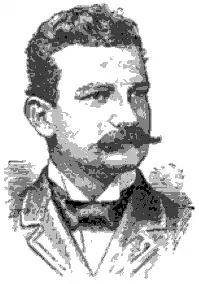John G. Agar (lawyer)
John Giraud Agar (June 3, 1856 – September 20, 1935) was a prominent New York lawyer and a leader of the reform political movement.
John G. Agar | |
|---|---|
 | |
| Born | John Giraud Agar June 3, 1856 New Orleans, Louisiana |
| Died | September 20, 1935 (aged 79) Premium Point, New York |
| Education | |
| Occupation | Lawyer, politician |
| Spouse(s) | Agnes Louis Macdonough
(m. 1892) |
| Children | 5, including Herbert Agar |
| Signature | |
Early life and education
John G. Agar was born in New Orleans on June 3, 1856 to William Agar and Theresa Price.[1] In 1876, he graduated with a B.A. from the Georgetown University. Followed by a Masters of Arts in 1888 and a Doctor of Philosophy in 1889 and a Doctor of Laws in 1910. In 1878, he attended the Columbia College Law School and graduated in 1880. On February 28, 1892, he married Agnes Louis Macdonough. Together, they had five children including Herbert Agar, winner of the Pulitzer Prize for History. His son and namesake John G. Agar Jr. died in WW I in October 1918 at St. Mihiel, northern France.[2][3][4]
Career
In 1881, Agar was appointed Assistant Attorney for the Southern District New York by President Garfield. He resigned in 1882 to become a senior member of Agar, Ely, and Fulton, a role he held until his death.
In 1896, he was named a school commissioner on the New York City Board of Education and is credited for removing education from politics and obtaining better funding for public schools.[2][5] He resigned as school commissioner in 1899 after faulting Tammany Hall for not releasing the funds raised for building and improving schools; removing the requirement for teachers to hold a license; and giving more power to those in politics to choose principals that aligned with their beliefs rather than the best for the job. Due to these defects, Agar declared he could not accomplish anything good for the public school system.[6] After his resignation, Agar proposed to fix these defects by making the Board of Education separate from the political governance of the city; control over finances through a school tax that would fund public schools; and limit the number of school Commissioners to increase their control of funds and responsibilities.[7]
From 1906 to 1908, he was a member of the Municipal Art Society (MAS) and president of the Reform Club. In 1908 and 1909, he was president of MAS followed by service as the third president of the National Arts Club from 1910 - 1932.[2] In 1913, Agar delivered a speech at the 8th annual Fifty Books of the Year Exhibition at the National Arts Club, where he announced the founding of the American Institute of Graphic Arts. The organization was to promote and encourage those in the graphic arts to exchange views, publish books and periodicals, hold exhibitions and lectures, and promote higher education in the arts.[8][9] In 1924, he was award the AIGA Medal.[10]
In 1916, he was appointed Knight of the Order of St Gregory by Pope Benedict XV and was a trustee of St. Patrick's Cathedral.[2] And in 1928, he became president of the Arts Council of New York City.[11]
In 1926, Agar successfully petitioned the New York Court of Appeals to raise the requirements for admission to the bar. Agar produced a report with the Committee on Character that described ignorance and unfitness among a large population of the candidates for the bar and recommended that at least two years in college in addition to three years in a recognized law school be required.[12][13]
Death
Agar died September 20, 1935 in Premium Point, New Rochelle, New York and was buried in Woodlawn Cemetery.[14]
References
- The National Cyclopaedia of American Biography. III. James T. White & Company. 1893. p. 325. Retrieved August 26, 2020 – via Google Books.
- "John G. Agar, 79, Lawyer, is Dead; Ex-Member of Westchester County Park Board Once a Reform Leader Here". Retrieved November 29, 2016.
- "Yesterday's Weddings.; Agar -- MacDonough". Retrieved November 30, 2016.
- "Mrs. John G. Agar, Widow of Attorney; Husband Was a Civic Leuder-3 Sons Also Prominent". Retrieved November 30, 2016.
- "The New School Commissioner". Retrieved November 30, 2016.
- "Leaves the School Board; John G. Agar Resigns Because He Can Accomplish Nothing. Sees No Chance for Reforms; Declares that Talk About Tammany Favoring Improvements on a Generous Scale Is False". Retrieved November 29, 2016.
- "Defects in the City's Educational System". Retrieved November 30, 2016.
- Thomson, Ellen Mazur (January 1, 1997). The Origins of Graphic Design in America, 1870-1920. Yale University Press. ISBN 0300068352.
- "ARTS CLUB WARNED OF 'THOUGHT TRUST'; While It Plans for Graphic Arts, Bacheller Also Warns of Our Europeanization. NEW THEMES FOR NOVELS Getting Away from Work, He Finds Butcher's Daughter Cultivates Only Ease and the Graces Now" (PDF). Retrieved November 30, 2016.
- Leonard, Anna B.; Robineau, Adelaide Alsop (January 1, 1911). Keramic Studio. Keramic Studio Publishing Company.
- "John G. Agar Heads Arts Council". Retrieved November 29, 2016.
- "New Move to Bar Unfit as Lawyers; Petition to Appellate Court Asks Public Hearing to Settle the Problem. Agar Behind the Plan; His Letter to Judge Cardozo Cites Committee's Report, Which Found Many Applicants III Prepared". Retrieved November 30, 2016.
- "Want College Men in Bar.; Character Committee Members Ask Two-Year Academic Minimum". Retrieved November 30, 2016.
- "Services are Held for John G. Agar; Requiem Mass is Solemnized in Paulist Church M Mourners Include Prominent Men". Retrieved November 29, 2016.